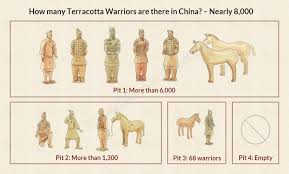
Types of Terracotta Warriors
The Terracotta Army, an awe-inspiring collection of life-size sculptures, is renowned for its vastness and the incredible detail of each individual figure. But within this massive underground army, there's a surprising level of diversity in the types of warriors represented. Each figure was meticulously crafted to fulfill a specific role in the afterlife army of Qin Shi Huang, the first emperor of China. Let's delve into the different types of Terracotta Warriors and explore their distinctive characteristics:
1. Armored Infantry
These warriors are easily identifiable by their heavy armor, designed to protect them in close combat.
- Armor: They are outfitted with breastplates, shoulder plates, arm guards, and leg protection, all meticulously crafted from terracotta.
- Weapons: Originally, these warriors would have carried various weapons, including spears, swords, and halberds.
- Formation: They were likely positioned at the front lines of the army, forming a formidable defensive wall.
2. Unarmored Infantry
These warriors are depicted in more simple attire, lacking the extensive armor of their counterparts.
- Clothing: They wear long robes and may have light padding beneath for minimal protection.
- Weapons: They carried a variety of weapons, including swords, spears, and crossbows.
- Role: These warriors may have been conscripts or lower-ranking soldiers, providing support to the heavily armored infantry.
3. Cavalrymen
Mounted on terracotta horses, these warriors represent the cavalry units of the Qin army.
- Distinctive Headwear: They are often depicted wearing a distinctive pillbox hat, which provided some head protection.
- Weapons: They would have been armed with swords, spears, and possibly bows and arrows for ranged attacks.
- Horses: The accompanying horses are incredibly lifelike, sculpted with dynamic poses and detailed features.
4. Chariot Drivers
Tasked with the critical role of driving and protecting the chariots, these figures had more armor than other warriors.
- Heavy Protection: Their armor resembles that of the armored infantry, reflecting the importance of their role in battle.
- Helmets: They wear distinctive helmets that provided additional protection for their heads and faces.
- Chariots: The chariots themselves are remarkable feats of engineering, with two wheels and drawn by two or four horses.
5. Spear-Carrying Charioteers
Positioned on the chariots, these warriors provided offensive capabilities.
- Weapon Specialization: Their primary weapon was the spear, used for both throwing and close combat.
- Limited Armor: They typically wear less armor than the drivers, allowing for greater agility.
6. Kneeling Crossbowmen/Archers
Representing the archers of the army, these warriors are depicted in a kneeling position.
- Armored Protection: Unlike the standing archers, the kneeling crossbowmen wear armor similar to the infantry.
- Powerful Weaponry: The crossbow, a technological advancement of the time, allowed for powerful and accurate shots.
- Strategic Formation: Their kneeling position provided stability and accuracy, making them formidable long-range attackers.
7. Standing Archers
These warriors represent the more traditional archers in the Qin army, using bows and arrows.
- Unarmored Attire: They are typically depicted without armor, emphasizing their role as long-range combatants.
- Agile Stance: Their standing posture allowed for quick movement and targeting.
8. Generals and Other Ranks
In addition to the various warrior types, the Terracotta Army also includes figures of high-ranking officers and possibly even the emperor himself.
- Distinctive Features: Generals are often distinguished by their more elaborate clothing, headwear, and weaponry.
- Commanding Presence: They are often depicted in poses that convey authority and leadership.
The variety of figures within the Terracotta Army highlights not only the immense scale of the project but also provides valuable insight into the military organization and tactics of the Qin dynasty. Each figure, painstakingly created with unique features and attire, contributes to the awe-inspiring legacy of this ancient wonder.
Q&A
1. What were the main weapons used by the Terracotta Warriors?
The Terracotta Warriors were armed with a range of weapons including spears, swords, crossbows, halberds, and bows and arrows.
2. Why are some Terracotta Warriors kneeling?
The kneeling figures are archers, specifically crossbowmen. This position provided them with greater stability and accuracy when firing their weapons.
3. How can you tell the rank of a Terracotta Warrior?
Rank can be determined by a figure's clothing, headwear, weaponry, and posture. Generals, for example, are often depicted with more elaborate attire and in poses that convey authority.